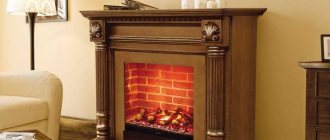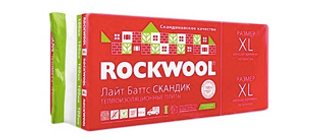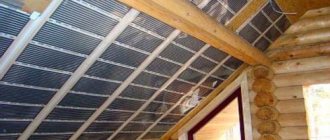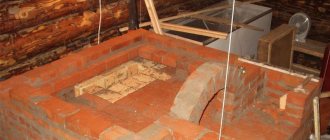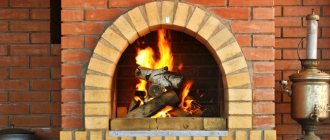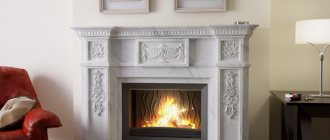Typical troubles are explained by various structural damages. When cracks appear, the seal is broken. Deterioration in draft provokes clogging of the smoke removal system. A large temperature difference (inside the channel and the surrounding air) can damage even high-quality masonry over time. In some situations, defects are formed due to user errors during operation.
To properly repair the stove, a preliminary inspection is necessary. It is recommended to pay attention to relatively rare design problems:
- if the height of the adjacent pipes is the same, the smoke is sucked in by the second (non-functioning) hole;
- the performance of the supply ventilation may not be sufficient for the simultaneous operation of several heaters;
It is recommended to check external conditions. In the above situations, wind currents can provoke forced “pushing” of smoke inside the building:
- the pipe is installed incorrectly in relation to the protruding roof ridge;
- parasitic vortices are created by a large tree or another structure.
Separately check the cleanliness of the chimney. In addition to soot, an obstacle can be created by a bird's nest or a separated part of a building structure.
Current repairs: prevention of serious damage
Professionals strongly recommend that you carefully inspect the condition of your home fireplace before the start of each heating season. Timely repair of stoves and fireplaces prevents accidents and fires.
Troubleshooting minor problems
Any owner can carry out minor repairs to a stove in a country house or in a residential building, even if he does not have construction skills.
- Scuffs that appear on the pre-furnace sheet make cleaning difficult and can cause a fire. The leaky metal must be removed, the flooring must be protected with a sheet of asbestos and roofing steel of the required size must be nailed on top.
- To replace the grate, you need to remove the old part from the furnace and clean the area of soot. The new grille should be exactly the same size as the failed one. It is laid in place without mortar in the same way as the old grate bars.
- Twice a year it is necessary to inspect the chimney for foreign objects and debris. To clean soot from channels, it is recommended to use special chemicals.
Renewing masonry joints
Leaky seams spoil the appearance of the brickwork and allow harmful gases into the room. To detect weak areas, it is recommended to heat the stove - this will make large cracks visible. To eliminate the problem, it is necessary to clear the seams by 2-3 cm, after soaking them with water. Next, the walls are washed well with clean water using a brush.
The resulting depressions are filled with new clay mortar, carefully compacting the mixture and wiping out the voids. To increase the resistance of the solution to cracking, you can add a little table salt to the clay - 300–350 grams per bucket of solution. It is recommended to seal wide cracks with fire-resistant cord. If necessary, the walls are plastered and whitewashed or tiled.
Sealing of the combustion door and hob
The gaps that form between the doors and the masonry due to mechanical loads and thermal expansion also begin to let dangerous gases into the room. Do-it-yourself oven repair in this case begins with cleaning the surface and removing the old mortar. The cleaned area is washed and primed with heat-resistant glue diluted in the same volume of water.
A sealing asbestos or ceramic cord is attached around the perimeter of the door - it protects the clay from cracking, compensating for differences in the thermal expansion of materials. To avoid buying a fake instead of a fire-resistant cord, experienced stove makers recommend setting fire to your purchase without leaving the cash register. Next, the area around the door is rubbed with a repair solution and left to dry for at least a day.
Similarly, the gaps that appear between the hob and the walls are eliminated. To remove the stove, the stove should be heated a little, and then pry off the cast iron with a hard metal object, such as an ax. Instead of a cord in this case, you can use basalt wool or felt. If possible, the old stove can be replaced with a more modern one.
What to do if cravings worsen?
Good stable draft is necessary to maintain the correct combustion mode, which requires the supply of the required amount of oxygen to the firebox and the unhindered removal of combustion products - smoke, soot, soot, as well as gases formed during the combustion of fuel.
During the construction of the furnace, gas ducts (chimneys) of the required size are installed, capable of passing the amount of smoke that is generated during the combustion of fuel. But, over time, a thick layer of soot accumulates on the walls of the flues, which reduces the cross-section of the chimney and prevents the free passage of exhaust flue gases, creating additional resistance to their movement.
As a rule, the appearance of a large amount of soot is associated with the use of firewood containing a large amount of resinous substances, which do not have time to burn completely and fall out on the walls in the form of layers of soot. Damp firewood also produces a large amount of soot.
To improve draft in this case, cleaning the pipe that removes smoke from the firebox will help. You can read how to do this in the article “How to clean a bathhouse chimney.” Also, the draft may be disrupted due to leaks in the stove lining, cracks in the walls and in the masonry of the chimney. Moreover, destruction of the masonry can occur not only within the heated room, but also outside the building - if the pipe masonry on the roof cracks and collapses, the draft will also be disrupted. How to eliminate cracks that appear, read below.
Types of furnace malfunctions. Minor damage
Furnace repairs can be divided into minor, medium and major repairs. So, minor repairs, despite the fact that its name sounds so undignified, are just as important as the rest. This is not just cosmetic repairs that can be put off for better times until, say, you are in the mood to do it. Current repairs include replacing doors, grilles, valves, if necessary - replacing a brick or two, filling up cracks, in a word, repairing everything that can break.
If you need to strengthen or change the fire door, then sometimes you need to not just remove it along with the frame, but also disassemble the masonry a little. Then, depending on what you planned, continue the work. Broken frame claws must be replaced; if you install a new door, install new claws for it as well. Before installing the door, you need to thoroughly clean the masonry and moisten it with water. The frame must be installed so that the legs fit into the seams. Then the masonry is completed and the seams are filled with mortar. If the bricks become bad, we replace them with new ones. During the laying process, the frame should be at a distance of 5-10 mm, which is filled with asbestos cord. In cases where the latter is not at hand, the masonry should fit snugly against the frame and secure it firmly. In this case, the door will not become loose and fall out. If you do not install the claws, then such a door will not last long and will soon fall out. The next final step is to cover the seams and cracks with clay mortar. (See also: DIY greenhouse stoves)
To change the grate, first of all you need to remove the old one and thoroughly clean the installation site of waste (ash), and only then install a new one. If the grate that you removed stood a little higher and deeper, then when installing a new one you need to be guided by the placement of the previous one and repeat its location. The entire perimeter between the brickwork and the grate should have a small gap of 5 mm, filled with ash or sand.
If, over time, cracks appear in the masonry seams, this can become very dangerous not only for your health, but also for your life, therefore, as soon as you notice them, the damage must be corrected. To do this, the seams in those places where the cracks need to be cleared to a depth of 2-3 cm, generously moisten with water and cover with clay mortar. It is noteworthy that the applied solution must be thoroughly rubbed.
If everything is much more serious and cracks appear in the bricks, then operation of the furnace is impossible until this problem is eliminated. Bricks with cracks must be removed and the mortar removed from the area they occupied. From the new bricks, select a whole durable brick that will fit perfectly in place of the cracked one, generously moisten it with water and, having spread a clay solution on it, insert it back. If you see that the seams remain half-empty, then, as necessary, coat them with the solution and rub it in. (See also: DIY fireplace stove)
Self-repair of the furnace firebox may include replacing tiles. If several tiles have cracked over time, the cracks can be repaired using a gypsum solution with aluminum-potassium alum. Chalk prepared with egg whites is also suitable. If the tiles cannot be repaired, it is best to replace them with ones that match the color and shape. As in the case of bricks, the cracked tile is carefully removed and the area is cleaned of mortar. The new tile is given the shape of the old one, the tile rum is filled with a mixture of clay mortar with crushed brick, and installed in place of the old one. Naturally, the strength of such “repaired” tiles is not too high, since during laying the tiles are additionally reinforced with wire, but this is still better than using a stove with cracked tiles.
Repairing a cast iron firebox involves welding, turning or replacing seals. It is better to entrust this work to professionals, since its cost is not too high, but such repairs may cost more for an amateur. So it’s better not to skimp and turn to experienced workers.
Serious problems
Sometimes the damage to the brickwork is so serious that in order to restore the functionality of the heating system, individual parts will have to be completely replaced. Most often, craftsmen have to change the lining of the firebox, which consists of fireclay bricks.
If there are serious faults, you should entrust the repair to specialists
If the damage is not global in nature, then you can cope with the task directly through the firebox window. For restoration you need to use a fireproof mixture. All defective areas are carefully covered with it.
In case of serious damage, some of the bricks will have to be replaced. This must be done in the following sequence:
- Prepare the repair mixture in advance.
- Soak and remove the old mortar in the area where the brick will be replaced.
- Remove damaged lining elements.
- Thoroughly clean the vacated areas, moisten them with water and lubricate them with the repair mixture.
- Install new fireclay bricks and carefully seal the seams with refractory mortar.
When replacing individual lining elements, you need to ensure that the new brick is homogeneous with the old one. Otherwise, due to the difference in thermal expansion, the destruction of the furnace protection will continue.
It is possible to completely replace fireclay bricks in a firebox only by completely disassembling the wall. This is a difficult job that should not be performed without experience, as there is a risk of serious damage to the underlying masonry.
Serious repairs also include repairing the chimney and switching the brick stove to a different type of fuel. In the first case, you will have to go through the masonry and re-plaster it. In the second, you will need to completely redo the firebox.
The main causes of furnace malfunctions
For those who do not quite understand the question of why a serviceable and properly operated stove in a country house or in a house requires repairs, let us give a short explanation.
As you know, certain areas of the stove operate under extreme conditions, especially the firebox and chimney.
This is affected by the effects of high temperatures during fuel combustion.
- As you know, when heated and cooled, materials significantly change their volume.
- It may not be noticeable to the eye, but a heated brick exceeds the volume of a similar cold one.
- When examining a brick stove, you can observe the following picture: cracks appear on the plastered surface, and on stoves without plaster you can see cracks in the masonry seams.
- Sometimes small dark patterns are observed around the metal parts of the oven, dampers, and doors.
- These are all the result of materials expanding and contracting as they heat and cool.
Differences in materials as the main difficulty
It is important to understand here that, for example, a brick oven consists of various materials. Even if fireclay bricks and clay mortar are used for adhesion, which consist of the same basic material - clay, their coefficient of thermal expansion will be completely different, not to mention the metal parts of the furnace.
- used in masonry heat up unevenly .
- The part of the firebox closest to the fire warms up faster and more than the part further away, horizontal and vertical expansion occurs, and the bricks also have different expansion coefficients in their structure.
In other words, during operation the oven constantly changes its shape depending on the temperature conditions. It is not at all surprising that over time, any stove requires repairs, in addition to taking good care of itself.
Furnace malfunction: first signs of concern
Clogged smoke duct
Typically, repair of a Russian stove is required when the draft suddenly disappears. As you know, the quality of draft is primarily affected by the correct design of the chimney. If your stove worked properly from the very beginning, and then after a few years of operation the draft suddenly disappeared, this indicates that the smoke exhaust channels are clogged . So, repairing stoves in the country often involves cleaning the chimney yourself.
Fuel is another important factor
As mentioned above, temperature influences the brickwork.
It may happen that a piece of brick fell off inside the smoke channel and clogged the channel. This situation is quite difficult to resolve. Serious repairs to brick stoves will be required, which will not be easy to do with your own hands.
But don’t rush, it may also happen that a large piece of soot just fell off the chimney walls and clogged the channel. This can quite often happen in stoves where coniferous wood is used as firewood: pine, spruce. Such firewood splits well, but when burned it produces very large soot due to the presence of resin in it.
We burn smoke channels
To clean the chimney of a stove in the country with your own hands, proceed as follows:
- Let's heat the stove well using alder or aspen wood.
- After the firewood is well lit, throw a handful of regular table salt into the fire.
- If the channel is blocked due to soot, using this method you can thoroughly clean the pipe and burn out all the soot.
- Well, if this method does not give a positive result, you will need to dismantle the chimney masonry in search of stuck bricks.
Our information: usually competent stove makers leave a sufficient number of doors or knockout bricks for cleaning.
How to identify knockout bricks?
If you purchased a house with a stove and do not know where the knockout bricks are located, proceed as follows:
- Inspect the oven carefully.
- Focus on the places where the smoke channels pass.
- The knockout bricks are mounted with a slight offset outward relative to the main masonry by a few mm.
- After cleaning the mortar around such a brick, you can easily remove it.
- Access to the channel is provided.
- Having cleared the channel and pulled out the stuck brick, you can replace the knockout and coat it with clay.
Our advice: If you have removed a stuck brick from a chimney, try to locate the location from which it fell. If this happens in winter, then you can operate your stove until spring. But with the onset of warm weather, major repairs of the furnaces will be required. A fallen brick is the first sign of the destruction that has begun.
Features of “dacha” life
Such repairs of stoves in the country are especially often required. The point is not even that modern stoves are not installed quite correctly and competently. This most likely occurs due to improper operation of the stoves.
After all, as a rule, country stoves are not used entirely for their intended purpose: they cook food and heat the house, but sometimes they also burn household waste.
It is understandable that people want to keep their area tidy and clean, but we must also take into account the fact that the oven was not originally designed for recycling household waste, rags, and especially plastic bottles and packaging.
General progress of capital repair work
To carry out independent repairs of brick kilns, it is necessary to carry out a general course of work, usually capital work. Among them:
- A visual inspection that reveals the reasons for the malfunction of the structure, the further progress of the repair, i.e. partial restoration of individual elements or complete replacement of its main parts.
- Elimination of everything unnecessary, for example, what was installed incorrectly (in case of a serious defect).
- Adding the necessary elements that will help the furnace operate with higher efficiency, i.e. upgrading the existing design to the extent possible.
- The need to restore or resurface brickwork by covering it with new clinker tiles.
- Cleaning the chimney on the roof and the stove pipe itself inside the house. If desired, the part of the chimney that is located in the room can be lined with porcelain stoneware to obtain a pleasant visual effect.
- Installation of useful accessories (for example, a new hob, firebox door or blower), if necessary or present when repairing the stove.
Your own summer cottage outside the city is a place where you want to come at any time of the year, including in winter. Therefore, try not to skimp on heating and repairing the housing located on it.
//www.youtube.com/watch?v=dISTLMZCMvU
Main problems and how to fix them
Minor problems
- Abrasions that appeared on the firebox sheet. They can cause serious problems and even fire. To solve the problem, the worn sheet is replaced with a new one. To do this, we dismantle the deteriorated metal, protect the floor covering with an asbestos sheet and attach a new sheet of metal of the required size on top.
- Replacing the grate from the grate.
- Lack of traction. If the draft is lost, most likely you are faced with a clogged chimney or lack of air flow. Once a year, inspect your chimney for dirt, debris, and foreign objects. Chemicals are used to clean the canals.
Cleaning the chimney with chemicals
To clean the chimney from soot, you will need to prepare:
- Firewood
- Trowel with sharp edges
- Soot scraper
- Clay mortar for masonry
- Lime and plaster for whitewashing
The entire work process comes down to heating the stove with wood. It is better to use alder or aspen firewood, as they burn out quickly, produce good draft, and burn out soot. Sprinkling salt on your firewood can help clear soot from your chimney and chimney. This procedure is recommended to be carried out every three months.
Replacing the grate comes down to:
- Removing old grates
- Carrying out repair work on masonry and ashlars if necessary
- Laying a new grate, remembering to leave 5 mm gaps
- Filling gaps with sand or ash
Attention: the new grate from the grate must strictly match the old one in size. It must be placed in its original place without using a solution.
Medium difficulty problems
- Loose fire door
- Damaged chimney pipe
- Repair and refurbishment of the firebox
Medium repair work also includes updating masonry joints. They not only spoil the appearance of the structure, but also allow harmful gases into the room. To identify problem areas, it is recommended to heat it. To solve the problem you need:
- Clean out the seams.
- Wash the walls with water using a brush.
- Fill noticeable cracks and defects in the brickwork with a new clay solution.
To prevent the clay from cracking after drying, add a little table salt to it. For one bucket of clay, it will be enough to add 300 grams of salt. If the cracks in the masonry are large and deep, they should be sealed using a fire-resistant cord.
A loose fire door can be strengthened. If you notice that cracks have formed around the doors, and it is very wobbly, it’s time to repair it:
- We clean the repair area down to the brick and rinse it with water
- Prime the surface
- We put sealant in all cracks
- Seal it with mortar
To prepare the solution we will need to take:
- Fireclay clay
- Heat resistant glue
- Portland cement
- Sand
The prepared composition should be similar in consistency to sour cream.
After strengthening the fire door, after 24 hours, you should heat the structure with a small amount of firewood.
Capital works
- Complete replacement of the lining
- Converting a stove from one type of fuel to another
- Repair and re-laying of brickwork
Repair without disassembling the stove
If you need to replace burnt bricks without disassembling the stove, prepare the following materials and tools:
- Brick
- Hammer
- Masonry mortar
- Water
- Scraper and trowel
Instead of old burnt bricks, it is necessary to lay new material, having previously moistened them with water. Next, apply the solution to the masonry.
Attention: with the prepared solution you must thoroughly lubricate the area of the fallen brick. The new material is placed in its original place, pressed and sealed.
How to move the firebox
It also happens that the refractory brick from which the masonry is laid collapses and becomes unusable. In this case, it is necessary to repair it through the combustion door. If the damage is small, clay mortar will help to cope with it. If only a few bricks are destroyed, it is recommended to replace them by removing the old mortar.
To complete the work you will need to prepare:
- Spatula, hammer and chisel
- Solution
- Water
- Fire brick
The old mortar is removed with a construction tool, the area is moistened with water, and new bricks are laid on top.
When repairing the firebox, it is advisable to use the same solution that was used during construction. After repairing the firebox, you will be able to use the stove only after a week.
How to restore a stove
If you want to restore an old brick stove and restore its aesthetic appearance, you should stock up on the following materials:
- Heat resistant tiles
- paint
- Whitewash or lime
When decorating a stove with tiles, it must be laid on a prepared and flat surface. Be sure to use bas-relief edgings and frescoes. The advantages of this material include:
- Ease of care
- Presentable appearance
- Durability
If you want to paint the stove, pay attention to the material that can withstand temperature changes. To give the product originality, use a stencil to paint designs and ornaments.
Whitewashing the stove is the most common option. To give a snow-white shine to the lime, add salt.
Safety precautions when repairing furnaces
Before you start repairing a brick kiln, be sure to take care of safety precautions:
- To prevent wooden surfaces from heating up and catching fire, use insulating materials adjacent to the heated part.
- Choose your supplies carefully. They must be of high quality and without visible defects.
- To prepare the solution, it is recommended to use fatty clay and heat-resistant glue.
- Before starting work, place a steel sheet in front of the vent.
To summarize, it is worth noting that timely preventive maintenance and repair of minor problems will significantly extend the life of a brick kiln. Keep in mind that repair work must be carried out with full responsibility, since not only the performance of the structure and its appearance, but also the safety of your home depends on it.
When inspecting the furnace, the following facts may be revealed:
- The device does not have an additional blower, the so-called letnik, which enhances the stove draft when it is lit.
- Changing the location of the blower: instead of the lower part of the firebox (under the door), it is located at the end of the stove.
In addition, there may be no additional hood above the hob, and the heating of the room is less on the side where another wall is located. These errors also need to be corrected.
The second disadvantage is the location of the view relative to the smoke channel going up. From an ergonomic point of view, this valve cannot be positioned horizontally all the time. This leads to disruption of its operation or, as stove makers aptly put it, to “tears of the stove.” The fact is that in winter, especially during frosts, a lot of condensate accumulates in the equipment, which, mixing with soot, turns into a solution of high concentration carbonic acid, which leads to the gradual destruction of the masonry.
So, thanks to an external inspection, it was possible to identify problem areas that need to be worked on. After this, you can begin repairing the brick oven with your own hands.
Some tips
Timely maintenance of the fireplace can include all routine repairs. Therefore, correct maintenance ensures that major repairs that require stopping the fireplace can be avoided. React promptly to the slightest manifestation of questionable signs. If you don’t put off work, you will get by with minimal losses. There are many cases in practice where the smallest defects over time lead to large-scale repairs.
Check the condition of clay surfaces every two weeks. The patency of the chimney channels can be determined by looking into the pipe from the bottom up from the firebox. Don't forget about seasonal maintenance. Prolonged downtime of the fireplace can lead to partial destruction of the masonry. Therefore, when opening the winter season, make sure that there is traction and structural integrity.
Replacing the pre-furnace sheet
Sometimes, torn spots appear on the fire-resistant metal sheets attached to the floor in front of the furnace firebox, causing some inconvenience during cleaning. They also increase the risk of fire if the stove is located in a gazebo or similar structure that has a wooden floor.
In this situation, you do not need to wait until the sheet is completely soaked, but you should tear it off and remove the nails from the floor. Then you need to put in its place a sheet of asbestos or felt soaked in a clay solution. Then lay a new sheet of roofing steel on top and secure it with nails.
Fireproof cuttings (as a rule, these are metal sheets on the walls near the stove, although there is also a narrow brick strip).
In principle, the repair of these elements is similar to pre-furnace sheets. Typically, cuttings fail due to settlement of structures and various mechanical shocks. The reason may also be due to initially poor quality materials or installation. The cutting thickness is determined by the size of the oven.
Replacing unusable bricks
If a brick is cracked, it is beaten, loosened and pulled out, its nest is cleared of the remaining mortar, a suitable size is found or cut, a new brick is chipped to the required size and tried on instead of the old one. Both the nest and the brick itself are thoroughly moistened, then a clay solution is applied to the brick and inserted into place. If there are voids in the seam, add mortar, press and rub with moderate force, achieving a smooth surface.
If it is necessary to repair the firebox and the very bottom of the chimney channels, the highest quality brick is selected for high-temperature areas, and the remaining brick is used in areas with lower temperatures.
As a result, the channels should be smooth so that gases move without interference. Accordingly, less condensate will form and it will evaporate more actively.
During repairs involving the replacement of bricks, they often have to be chipped. The chipped side cannot be placed inside. Moreover, these sides must be cut off, treated with a file or coarse sandpaper in any case - the treated bricks will last longer.
All sharp corners are cut off and rounded, because they are an obstacle to the free movement of gases.
The repair scheme is standard. First, the old brick is removed, the surfaces are cleaned of any remaining mortar using a metal brush, a clay mortar is applied, and a new treated brick is placed.
Strengthening and replacing the fire door
Furnace doors are prime candidates for repair because they are constantly being opened and closed, weakening the surrounding masonry. Door frames are one of the weakest links in the design. As a rule, quite large cracks appear around the doors, especially at the top, and the frame with the door becomes more and more loose.
If you need to remove the frame, you cannot do without disassembling part of the stove, since during installation the door frame was inserted into the masonry using strips of metal. However, in many cases it is not necessary to carry out such dismantling - it is enough to strengthen the frame. To do this, the gap around it is cleaned, the surfaces are washed with water and treated with a stiff brush, which removes any remaining clay and soot, then coated with a primer. A sealing insulating cord is inserted around the perimeter (usually asbestos is used, although it has a significant drawback - at elevated temperatures it can release harmful substances). Therefore, it is better to use, for example, a ceramic cord or mineral basalt wool.
Then the gap is covered with a solution. And not in the same way as during construction, but on the basis of fireclay clay. Heat-resistant glue and Portland cement should be added to the solution: clay, fine-grained sand, cement (3: 10: 1) plus a little hot glue. The consistency of the final substance is creamy and thick. In order not to stain the door itself and the surrounding bricks, they are sealed with masking tape.
Before lighting the stove, you need to wait a day. At first, you shouldn’t put a lot of firewood.
Heating in the house
The heating system can have several types:
- The room is heated only by a small stove with a hob. This option is suitable for a small space, as well as in cases where you rarely visit the dacha.
- Heating using a heating system in the form of pipes passing through the furnace. In this option, heat is accumulated and distributed through pipes filled with antifreeze or water. The option is perfect for heating a room of 40 m2, but you should take into account the features and costs (you need to purchase a pressure meter, a pump, supply water to the house, etc.).
- Heating the room using a fireplace. The fireplace gives off heat well during the burning of wood, but does not retain it. This option is suitable for quickly warming up a room to room temperature, but it is not profitable to use it all the time.
- An ordinary stove is rough or potbelly stove. This type of stove does not take up much space and is the most economical option for a summer resident. The efficiency of this type of furnace is very high - this is due to its structure and the presence of many passages.
Pipe
The pipe is exposed to a rather aggressive effect not only of high temperature, but also of precipitation and wind. It is not surprising that after some time it begins to collapse and threaten with fire (of course, metal pipes are much more durable than brick ones, and usually they do not need to be repaired). Brick pipes are repaired with high-quality bricks, dismantling the problem area and clearing away any remaining mortar. Having moistened the new brick and the nest under it with water, make a new laying with cement or mixed mortar, not forgetting to carefully bandage the seams. The cement at the very top of the pipe can be beveled from the inside to the outside to facilitate the movement of gases. In addition, it is recommended to install a protective metal cap on the pipe. It is important to protect the pipe from moisture getting into it, since if the stove gets wet from the inside, the draft will deteriorate.
To eliminate the danger of condensation, it is sometimes necessary to reduce the number of turns in the chimney or to gain access to them by creating a window measuring 5x5 cm in each turn. As a rule, a window is made in the last two chimneys, but it may be more profitable to remove a couple of them . To do this, you will need to disassemble the wall from the bottom and top and then assemble it in the same order. In any case, the restoration of disassembled walls must be approached very responsibly.
Sometimes, for optimization purposes, it may be necessary to convert a firebox with a solid hearth to a firebox with a blower and grate. Manipulations with the furnace door are not required if the base of the structure is at least 5 rows of bricks away from the hearth, otherwise the door will have to be lifted. This is done taking into account the fact that the height of a wood firebox is at least 50-55 cm, and a coal firebox - from 40-45 cm and above. In the latter case, the blower and combustion doors must be closed very tightly, and holes with a diameter of 1-1.5 cm are made in them to allow gases to escape. The size of the grate in a stove that uses anthracite is no different from the grate in a wood-burning stove, but the profile is more massive. The work is done like this. They remove the door, dismantling the front wall of the structure and underneath, remove the debris and begin to lay a new configuration with a blower, a blower door, a grate and moving the fire door, if necessary, after which they wall up the wall with careful bandaging of the seams.
A complete overhaul is when you need to convert one stove into two or into a fireplace stove. For this, of course, the initial structure must be large. The implementation of this idea sounds simple, but it will require full-fledged stove-maker skills. First, he draws up a plan on paper, then dismantles some wall, determines the required dimensions and mentally divides the interior of the furnace into two independent areas with fireboxes and smoke exhaust systems, which are integrated somewhere above so that the smoke escapes into the atmosphere through one pipe. However, if this cannot be done, then two separate pipes can be made.
How to prevent cracks in your cooktop
In heating and cooking stove designs, the “sore spot” is the cast iron hob. Cracks in the panel themselves do not interfere with the operation of the stove. If it is folded correctly, it has good traction and cracks do not cause any inconvenience. But - for the time being. If the design of the stove is broken or there are errors in the masonry, then carbon monoxide can leak through these cracks. And this is a big threat to the lives of people who are in the room.
As a rule, high-quality cast iron panels almost never crack. But it's better to be safe.
In order to prevent cracks from appearing on the panel, the first heating of the stove with a new hob is done carefully, warmed up slowly, without loading the entire firebox. To distribute heat evenly over the panel, pour a thick layer of sand on it, or lay out a brick
Remove the sand or remove the brick from the panel only after it has completely cooled. A uniformly loaded panel will “sit down” without distortions, which means there will be no “stress” cracks in it.



